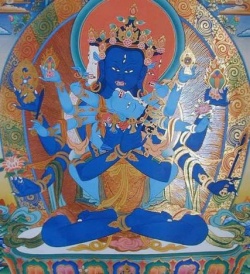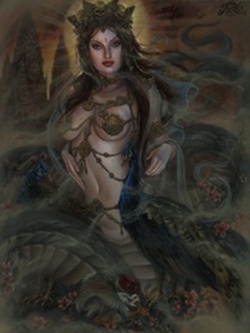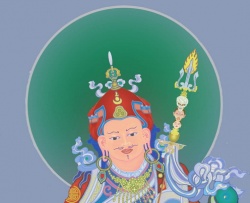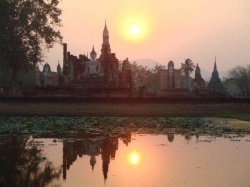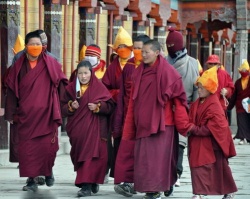Difference between revisions of "Discussing about Shariras"
(Created page with " <poem> By Venerable Shen-Kai The Sharira is truly a very amazing and miraculous object. Though it is a material substance, it can also be said to be {{...") |
|||
| Line 1: | Line 1: | ||
| − | + | {{DisplayImages|1126|2652|1392|419|2827}} | |
<poem> | <poem> | ||
By [[Venerable]] [[Shen-Kai]] | By [[Venerable]] [[Shen-Kai]] | ||
| − | The [[Sharira]] is truly a very amazing and miraculous [[object]]. Though it is a material [[substance]], it can also be said to be {{Wiki|immaterial}}. However, only the [[Buddhas]], [[Bodhisattvas]], great [[Masters]], [[saints]] and [[Bhikshus]] would have [[shariras]]. Some lay [[Buddhists]] who are great practitioners, both {{Wiki|males}} and females, may also have [[shariras]]. Typically, after the [[practitioner]] passes away and is [[Wikipedia:cremation|cremated]], numerous colourful bead-like [[objects]], known as [[shariras]], would be retrieved from the ashes. It does not melt under high temperature, does not dissolve with high humidity, does not spoil under high pressure, and does not get destroyed over [[kalpas]]. Interestingly, not every [[Buddhist]] has [[shariras]]. [[Buddhists]] who do not practice, just as other [[people]] who do not believe in [[Buddhism]], would not have [[shariras]]. There are plentiful [[religions]] in the [[world]]. Why is it that the [[religious]] leader, [[missionaries]] and believers do not have [[shariras]]? There are also practitioners from [[religions]] other than [[Buddhism]], yet only [[people]] who practice the [[Dharma]] have [[shariras]]. Besides, one could also tell the level of practice through the number of [[shariras]] produced. Those with deeper level of practice would have more [[shariras]], while those with a shallow level of practice would have fewer [[shariras]]. If one has practiced for countless lifetimes, the number of [[shariras]] one would have the [[beauty]] of its {{Wiki|colour}} and luster and other miraculous occurrences would be even more incredible. | + | The [[Sharira]] is truly a very amazing and miraculous [[object]]. Though it is a material [[substance]], it can also be said to be {{Wiki|immaterial}}. However, only the [[Buddhas]], [[Bodhisattvas]], great [[Masters]], [[saints]] and [[Bhikshus]] would have [[shariras]]. Some lay [[Buddhists]] who are great practitioners, both {{Wiki|males}} and females, may also have [[shariras]]. Typically, after the [[practitioner]] passes away and is [[Wikipedia:cremation|cremated]], numerous colourful bead-like [[objects]], known as [[shariras]], would be retrieved from the ashes. It does not melt under high temperature, does not dissolve with high humidity, does not spoil under high pressure, and does not get destroyed over [[kalpas]]. Interestingly, not every [[Buddhist]] has [[shariras]]. |
| + | |||
| + | [[Buddhists]] who do not practice, just as other [[people]] who do not believe in [[Buddhism]], would not have [[shariras]]. There are plentiful [[religions]] in the [[world]]. Why is it that the [[religious]] leader, [[missionaries]] and believers do not have [[shariras]]? There are also practitioners from [[religions]] other than [[Buddhism]], yet only [[people]] who practice the [[Dharma]] have [[shariras]]. Besides, one could also tell the level of practice through the number of [[shariras]] produced. Those with deeper level of practice would have more [[shariras]], while those with a shallow level of practice would have fewer [[shariras]]. If one has practiced for countless lifetimes, the number of [[shariras]] one would have the [[beauty]] of its {{Wiki|colour}} and luster and other miraculous occurrences would be even more incredible. | ||
| + | |||
| + | According to the records of the [[life]] story of [[Buddha]], when [[Shakyamuni Buddha]] entered [[Nirvana]], At this moment, the golden coffin ascended to the height of seven duo luo [[trees]], moved around in [[space]], dissolved into the [[fire]] of [[Samadhi]], instantaneously producing ashes and [[shariras]] appeared, like multi-coloured beads, bright and firm. According to the explanations, there are as many as 84 dou3 [[shariras]]. At that [[time]], the [[shariras]] were divided amongst the 8 great [[Kings]] and other Buddhas [[disciples]]. They built [[stupas]] to venerate the [[shariras]]. While the majority of the [[shariras]] were left in the [[human realm]], some were kept in the [[Naga realm]] or [[Heaven realm]]. There was also Buddhas great [[disciple]], [[Venerable]] [[Ananda]]. | ||
| + | |||
| + | When he entered [[Nirvana]], his [[physical body]] levitated to the [[space]], dissolved into [[fire]] and self-cremated. His [[shariras]] rained down from the sky upon the banks of the [[Ganges]] [[river]]. All these did not only happen in the {{Wiki|ancient}} times. Even as recent as the great [[Buddhist]] leader [[Master]] [[Tai-Hsu]], when he passed away, there were more than 400 [[shariras]]. The [[Pure Land]] [[master]] [[Venerable]] [[Yin]] Kwang, also produced a few hundred [[shariras]] when he passed away. There are also other innumerable great [[Masters]] and [[Teachers]] who had [[shariras]]. There was especially a [[Zhang Jia]] [[Rinpoche]] who passed away in Tai Pei in 1957; he had as many as 7000 to 8000 [[shariras]]. He even had the most [[precious]] [[Vajra]] [[gem]] and [[six-syllable mantra]]. The [[shariras]] could be as large as beans and as tiny as [[seeds]]. They were very colourful, but the white ones were especially remarkable. Other than these, there are also uncountable accounts of [[Bhikshus]], [[Bhikshunis]], lay {{Wiki|male}} and {{Wiki|female}} [[Buddhists]] who passed away with [[shariras]]. | ||
| + | |||
| + | Actually, one need not to have [[shariras]] only upon ones [[Nirvana]]. For example, one of the greatest [[disciples]] of the [[Buddha]] [[Mahakashyapa]], his [[indestructible]] [[body]] [[sharira]] is presently concealed in the ling2 jiu1 shan1. He would await for the descent of the [[Maitreya Buddha]], when he would appear in the [[Dharma assembly]], [[benefit]] [[sentient beings]] and then enter into [[Nirvana]]. Other examples include the [[Ksitigarbha Bodhisattva]] of the Jiu Hua Mountain in An Hui; {{Wiki|Tang Dynasty}} 6th [[Zen]] [[Patriarch]] [[Hui Neng]] of [[Cao Xi]]; the {{Wiki|Ming dynasty}} [[Great Master]] [[Han Shan]]; Chinas [[Wu Jin Zang]] [[Bhikshuni]] etc, their [[body]] [[sharira]] are being venerated at [[Guang Dong]] in the [[Nan Hua]] [[monastery]]. | ||
| + | |||
| + | There is also a [[Venerable]] in [[Thailand]] who entered [[Nirvana]] in his middle age, but his [[body]] did not [[decay]], it is situated at [[Cheng Niang]] and the Thais venerate his [[Body]] [[Relic]]; it is also known that his [[hair]] is grew 5 times longer than when he was alive. In [[Taiwan]] Si Zhi [[Maitreya]] [[Monastery]], the Ci Hang [[Bodhisattva]] non-decayed [[Body]] [[Relic]] was a breaking news, [[people]] from local and abroad pay homage to it; in [[Nan Hai Pu Tuo]] Mountain [[Gu Fuo Dong]], there are many [[body]] [[relics]] of old [[monks]] who passed away for plenty of years. Regarding [[body]] relics/shariras, there are plenty of cases in different places and [[mountains]] in [[China]]. Those who follow and practice (xiu1 chi2) according to the [[Buddhadharma]], not only bone marrows, even {{Wiki|nails}}, {{Wiki|blood}}, flesh and {{Wiki|teeth}}, the entire [[body]] can become [[relics]], just like there are lights and colours on [??]s head. [[Venerable]] Jiu Mo Luos {{Wiki|tongue}} did not burn in [[cremation]], these are [[Sharira]] [[Gems]]. | ||
| + | |||
| + | [[Sharira]] can also be obtained through Gan3 Ying4 (induction/invocation), in our country ([[Taiwan]]) during the {{Wiki|era}} of Dong Wu [[Sun Quan]], after hearing that [[Venerable]] Fan Zeng [[Kang]] Zeng [[Kai]] said the [[merits]] of [[paying homage]] to [[shariras]], [[thought]] of wanting to pay homage to [[shariras]], therefore requested that [[Venerable]] to sincerely pray. After 49 days, he suddenly heard {{Wiki|sounds}} coming from the [[empty]] bottle, and discovered Gong-De-She-Li ([[merits]] [[sharira]]). After trying to hit it with a hammer on a metal [[zhuan]], the [[sharira]] remains undamaged. During the {{Wiki|Song dynasty}}, lay [[disciple]] [[Wang Ri Xi]] was carving a [[Pure Land]] [[scripture]] on the wooden plank and a [[sharira]] was carved out. Again in {{Wiki|Song Dynasty}}, there was a lady who always recited [[Amitabha Sutra]], in the [[sutra]] suddenly a lot of [[shariras]] appeared. During [[Xi Pu]] {{Wiki|era}}, there was a [[monk]] called [[Hui Da]], in [??], [[bowed]] and sincerely prayed for Buddhas [[relic]], suddenly the [[relic]] rolled out from the ground, it is now venerated at [[Ning Bo Ah]] Yu Wang [[monastery]], is known to be the [[relic]] that [[Venerable]] [[Hui Da]] prayed for. Recently there is a General, once he was at [[Xi-An Xi-Jiao]] [[Monastery]] [??] [[stupa]], he sincerely prayed and a huge brick fell out from the top of the [[stupa]], and [[realized]] that two [[shariras]] are on top of it, therefore he renovated the [[stupa]]. | ||
| − | + | In [[Hong Kong]], [[Venerable]] Lan Mo went to [[India]] for [[Buddhist pilgrimage]], in Buddhas pre-enlightenment Bodhigaya; he met an old [[practitioner]], called Guang Qing Shi. He was at Jia ? [[Great Stupa]] venerating Buddhas [[relics]] for 3 years already, once he witnessed [[sharira]] dropping by itself from the top of the [[stupa]], and it even gave him and another lay [[disciple]] 2 [[shariras]]; it was very colourful and lovely. During [[Ming Guo]], [[Zheng Jue Sheng]] old lay [[disciple]] once venerated two of [[Living Buddha]] [[Ban Chans]] [[shariras]]; it automatically multiplied to 7 of them. When Mr Qu Lao passed away, his wife took 2 [[shariras]] and put onto his {{Wiki|mouth}}. When his [[funeral]] was over, it was found that that 7 [[shariras]] remain at home. Later it was given to [[Li Zi Kuan]] old lay [[disciple]] who is at {{Wiki|Taipei}} Shan [[Dao]] [[monastery]] for [[offering]], but [[realized]] the [[sharira]] has multiplied to 10. In [[Tibetan]] [[Vajrayana]] [[Yellow Hat sect]] leader [[Lama]] [[Tsongkapa]] dropped a tooth in his latter years, his [[disciples]] treated it as a [[sharira]] and venerated it, [[shariras]] grew out from the tooths [[root]] canal. | |
| − | + | It was distributed among masses for veneration, after distributing it grew again, after growing it was distributed again. It was known that there is a [[Living Buddha]], in the early years at [[China]] Mainland before his passing away, often there are [[disciples]] praying/requesting his [[sharira]], he could at any [[time]] drop 2 [[shariras]] from his nostrils and gave them for veneration. It was also heard that there is a {{Wiki|merchant}}, Da [[Pu Tuo]] and Bo Li Jia brothers, they used a [[jade]] box and carried back eight of Buddhas [[hair]] [[strands]] (also Buddhas [[sharira]]). They were robbed twice on their way by robbers, altogether they lost 4 strains. When they arrived back in [[Myanmar]] they asked the [[king]] to build a [[stupa]] for the veneration of the [[shariras]], and when they opened the box, they found 8 strains like it originally was. There are many cases of multiplication of [[shariras]] among those who venerate the [[shariras]]; and because whenever there are hosting of [[Buddhism]] [[activity]], often there are light-flower [[sharira]]. | |
| − | + | The author has been to different places in [[Taiwan]], visited and venerated [[Buddha]], [[Bodhisattvas]], [[Saints]], high [[monks]] and old practitioners of their [[shariras]], at [[Jia Yi Seng]] saw [[Zang Ji Hua]] old lay [[disciple]], because of his sincere praying and [[chanting]] [[Buddha]], obtained light-flower [[sharira]], at that [[time]] liked it a lot, therefore wished him when he pass away surely have [[sharira]], and it turned out that a few years ago Zhang Lao in {{Wiki|Taipei}}, fore-knew his [[death]] [[time]], died/liberated without [[sickness]] during [[meditation]]. After [[cremation]] there are plenty of big and small [[shariras]], there are [[sharira]]-tree and [[sharira]]-flower. Once also, visited [[Gao-Xiong-Shou]] mountain [[monastery]] [[Lamp-Burning puja]], saw a lot of lamp-flower [[sharira]]. Once more than 10 years ago at Xi Yi, visited various [[Venerables]] recently arrived back from [[India]] who brought back many [[Buddha]] [[Shariras]] for veneration. | |
| − | + | They are shaped like small peanut-grains, I witnessed the {{Wiki|colour}} was white, it was heard that white was good, some [[people]] saw golden-yellow or pale-yellow, some [[people]] saw [[sky-blue]] or green {{Wiki|colour}}, some saw red or purple {{Wiki|colour}}, some saw {{Wiki|pearl}} {{Wiki|colour}}, some saw [[jade]] {{Wiki|colour}}, or [[coral]]; ???? {{Wiki|colour}}, or if [[karma]] is heavy, some saw it as grey or black, or because of sudden sincere ?, or because of [[prostrations]] and sincere repentance, vowing to be [[virtuous]], the [[sharira]] {{Wiki|colour}} turned good; witnesses found it very mysterious. For example locally in the {{Wiki|present}} generation, there is a [[Fa Xue Jia]], Mr. [[Luo Jia Jie]], believed in [[Buddhism]], once he was at [[Ningbo Ah Yu Wang]] [[monastery]], prayed and venerated [[Buddhas]] [[shariras]], at first it was black {{Wiki|colour}}, and knew that he had heavy [[karmic obstructions]], therefore he stayed at the [[monastery]] for 7 days 7 nights and kept praying and repenting. At the 7th day, he visited the [[sharira]] again; it turned totally into white {{Wiki|colour}}, and was satisfied and left. [[Sharira]] in [[Buddhist]] disciples [[minds]], it is a great power without pens or ink or words, yet is able to invoke [[people]] to avoid [[evil]] and lead them towards the [[virtuous]] [[path]] and seek the [[truth]]. | |
| − | [[Sharira]] is formed due to the practitioners [[life]] [[merits]], due to [[love]], [[compassion]], [[joy]] and [[equanimity]] (the 4 [[immeasurable]]); [[wisdom]]; benefiting others and the worlds immense [[merits]]. It is difficult to obtain and rare, therefore it is said that [[shariras]] are {{Wiki|immaterial}}, it is beyond-material. [[Jing]] Guang [[Ming]] [[Sutra]] states Sharira is cultivated out of [[Precepts]], [[Samadhi]], [[Wisdom]] [[merits]], it is difficult to obtain and is the [[highest]] [[blessing]] field." And also, Persons of [[shariras]], is due to the results of immense [[cultivation]] of Six | + | [[Sharira]] is formed due to the practitioners [[life]] [[merits]], due to [[love]], [[compassion]], [[joy]] and [[equanimity]] (the 4 [[immeasurable]]); [[wisdom]]; benefiting others and the worlds immense [[merits]]. It is difficult to obtain and rare, therefore it is said that [[shariras]] are {{Wiki|immaterial}}, it is beyond-material. [[Jing]] Guang [[Ming]] [[Sutra]] states Sharira is cultivated out of [[Precepts]], [[Samadhi]], [[Wisdom]] [[merits]], it is difficult to obtain and is the [[highest]] [[blessing]] field." And also, Persons of [[shariras]], is due to the results of immense [[cultivation]] of [[Six Paramitas]] [[Prajna]] [[sutra]] also says [[Buddhas]] [[body]] and [[She Li Luo]] ([[She-Li-Zhi]]/[[shariras]]) is obtained through practice of [[Prajna-paramita]] immense [[merits]], it is venerated, revered, praised and respected by all [[Devas]] and Men. Therefore [[people]] of the [[world]] should inspire the [[heart]] of veneration towards [[Buddha]] and Bodhisattvas [[shariras]]; it will result in various [[blessings]] which are difficult to comprehend. |
| − | Due to the various ways of concrete [[proof]], [[shariras]] are not necessarily made of [[hair]], {{Wiki|blood}}, or marrow, the colours are not of white, black or 3 types, if the {{Wiki|Chinese}} translate it as body bones or or ling2 bones, ? bones, it is unable to cover the | + | Due to the various ways of concrete [[proof]], [[shariras]] are not necessarily made of [[hair]], {{Wiki|blood}}, or marrow, the colours are not of white, black or 3 types, if the {{Wiki|Chinese}} translate it as body bones or or ling2 bones, ? bones, it is unable to cover the [[sariras]] true [[essence]] and meaning. |
</poem> | </poem> | ||
{{R}} | {{R}} | ||
[http://sgforums.com/forums/1728/topics/312674?page=6 sgforums.com/] | [http://sgforums.com/forums/1728/topics/312674?page=6 sgforums.com/] | ||
[[Category:Relics of the Buddha]] | [[Category:Relics of the Buddha]] | ||
Latest revision as of 04:19, 23 April 2014
By Venerable Shen-Kai
The Sharira is truly a very amazing and miraculous object. Though it is a material substance, it can also be said to be immaterial. However, only the Buddhas, Bodhisattvas, great Masters, saints and Bhikshus would have shariras. Some lay Buddhists who are great practitioners, both males and females, may also have shariras. Typically, after the practitioner passes away and is cremated, numerous colourful bead-like objects, known as shariras, would be retrieved from the ashes. It does not melt under high temperature, does not dissolve with high humidity, does not spoil under high pressure, and does not get destroyed over kalpas. Interestingly, not every Buddhist has shariras.
Buddhists who do not practice, just as other people who do not believe in Buddhism, would not have shariras. There are plentiful religions in the world. Why is it that the religious leader, missionaries and believers do not have shariras? There are also practitioners from religions other than Buddhism, yet only people who practice the Dharma have shariras. Besides, one could also tell the level of practice through the number of shariras produced. Those with deeper level of practice would have more shariras, while those with a shallow level of practice would have fewer shariras. If one has practiced for countless lifetimes, the number of shariras one would have the beauty of its colour and luster and other miraculous occurrences would be even more incredible.
According to the records of the life story of Buddha, when Shakyamuni Buddha entered Nirvana, At this moment, the golden coffin ascended to the height of seven duo luo trees, moved around in space, dissolved into the fire of Samadhi, instantaneously producing ashes and shariras appeared, like multi-coloured beads, bright and firm. According to the explanations, there are as many as 84 dou3 shariras. At that time, the shariras were divided amongst the 8 great Kings and other Buddhas disciples. They built stupas to venerate the shariras. While the majority of the shariras were left in the human realm, some were kept in the Naga realm or Heaven realm. There was also Buddhas great disciple, Venerable Ananda.
When he entered Nirvana, his physical body levitated to the space, dissolved into fire and self-cremated. His shariras rained down from the sky upon the banks of the Ganges river. All these did not only happen in the ancient times. Even as recent as the great Buddhist leader Master Tai-Hsu, when he passed away, there were more than 400 shariras. The Pure Land master Venerable Yin Kwang, also produced a few hundred shariras when he passed away. There are also other innumerable great Masters and Teachers who had shariras. There was especially a Zhang Jia Rinpoche who passed away in Tai Pei in 1957; he had as many as 7000 to 8000 shariras. He even had the most precious Vajra gem and six-syllable mantra. The shariras could be as large as beans and as tiny as seeds. They were very colourful, but the white ones were especially remarkable. Other than these, there are also uncountable accounts of Bhikshus, Bhikshunis, lay male and female Buddhists who passed away with shariras.
Actually, one need not to have shariras only upon ones Nirvana. For example, one of the greatest disciples of the Buddha Mahakashyapa, his indestructible body sharira is presently concealed in the ling2 jiu1 shan1. He would await for the descent of the Maitreya Buddha, when he would appear in the Dharma assembly, benefit sentient beings and then enter into Nirvana. Other examples include the Ksitigarbha Bodhisattva of the Jiu Hua Mountain in An Hui; Tang Dynasty 6th Zen Patriarch Hui Neng of Cao Xi; the Ming dynasty Great Master Han Shan; Chinas Wu Jin Zang Bhikshuni etc, their body sharira are being venerated at Guang Dong in the Nan Hua monastery.
There is also a Venerable in Thailand who entered Nirvana in his middle age, but his body did not decay, it is situated at Cheng Niang and the Thais venerate his Body Relic; it is also known that his hair is grew 5 times longer than when he was alive. In Taiwan Si Zhi Maitreya Monastery, the Ci Hang Bodhisattva non-decayed Body Relic was a breaking news, people from local and abroad pay homage to it; in Nan Hai Pu Tuo Mountain Gu Fuo Dong, there are many body relics of old monks who passed away for plenty of years. Regarding body relics/shariras, there are plenty of cases in different places and mountains in China. Those who follow and practice (xiu1 chi2) according to the Buddhadharma, not only bone marrows, even nails, blood, flesh and teeth, the entire body can become relics, just like there are lights and colours on [??]s head. Venerable Jiu Mo Luos tongue did not burn in cremation, these are Sharira Gems.
Sharira can also be obtained through Gan3 Ying4 (induction/invocation), in our country (Taiwan) during the era of Dong Wu Sun Quan, after hearing that Venerable Fan Zeng Kang Zeng Kai said the merits of paying homage to shariras, thought of wanting to pay homage to shariras, therefore requested that Venerable to sincerely pray. After 49 days, he suddenly heard sounds coming from the empty bottle, and discovered Gong-De-She-Li (merits sharira). After trying to hit it with a hammer on a metal zhuan, the sharira remains undamaged. During the Song dynasty, lay disciple Wang Ri Xi was carving a Pure Land scripture on the wooden plank and a sharira was carved out. Again in Song Dynasty, there was a lady who always recited Amitabha Sutra, in the sutra suddenly a lot of shariras appeared. During Xi Pu era, there was a monk called Hui Da, in [??], bowed and sincerely prayed for Buddhas relic, suddenly the relic rolled out from the ground, it is now venerated at Ning Bo Ah Yu Wang monastery, is known to be the relic that Venerable Hui Da prayed for. Recently there is a General, once he was at Xi-An Xi-Jiao Monastery [??] stupa, he sincerely prayed and a huge brick fell out from the top of the stupa, and realized that two shariras are on top of it, therefore he renovated the stupa.
In Hong Kong, Venerable Lan Mo went to India for Buddhist pilgrimage, in Buddhas pre-enlightenment Bodhigaya; he met an old practitioner, called Guang Qing Shi. He was at Jia ? Great Stupa venerating Buddhas relics for 3 years already, once he witnessed sharira dropping by itself from the top of the stupa, and it even gave him and another lay disciple 2 shariras; it was very colourful and lovely. During Ming Guo, Zheng Jue Sheng old lay disciple once venerated two of Living Buddha Ban Chans shariras; it automatically multiplied to 7 of them. When Mr Qu Lao passed away, his wife took 2 shariras and put onto his mouth. When his funeral was over, it was found that that 7 shariras remain at home. Later it was given to Li Zi Kuan old lay disciple who is at Taipei Shan Dao monastery for offering, but realized the sharira has multiplied to 10. In Tibetan Vajrayana Yellow Hat sect leader Lama Tsongkapa dropped a tooth in his latter years, his disciples treated it as a sharira and venerated it, shariras grew out from the tooths root canal.
It was distributed among masses for veneration, after distributing it grew again, after growing it was distributed again. It was known that there is a Living Buddha, in the early years at China Mainland before his passing away, often there are disciples praying/requesting his sharira, he could at any time drop 2 shariras from his nostrils and gave them for veneration. It was also heard that there is a merchant, Da Pu Tuo and Bo Li Jia brothers, they used a jade box and carried back eight of Buddhas hair strands (also Buddhas sharira). They were robbed twice on their way by robbers, altogether they lost 4 strains. When they arrived back in Myanmar they asked the king to build a stupa for the veneration of the shariras, and when they opened the box, they found 8 strains like it originally was. There are many cases of multiplication of shariras among those who venerate the shariras; and because whenever there are hosting of Buddhism activity, often there are light-flower sharira.
The author has been to different places in Taiwan, visited and venerated Buddha, Bodhisattvas, Saints, high monks and old practitioners of their shariras, at Jia Yi Seng saw Zang Ji Hua old lay disciple, because of his sincere praying and chanting Buddha, obtained light-flower sharira, at that time liked it a lot, therefore wished him when he pass away surely have sharira, and it turned out that a few years ago Zhang Lao in Taipei, fore-knew his death time, died/liberated without sickness during meditation. After cremation there are plenty of big and small shariras, there are sharira-tree and sharira-flower. Once also, visited Gao-Xiong-Shou mountain monastery Lamp-Burning puja, saw a lot of lamp-flower sharira. Once more than 10 years ago at Xi Yi, visited various Venerables recently arrived back from India who brought back many Buddha Shariras for veneration.
They are shaped like small peanut-grains, I witnessed the colour was white, it was heard that white was good, some people saw golden-yellow or pale-yellow, some people saw sky-blue or green colour, some saw red or purple colour, some saw pearl colour, some saw jade colour, or coral; ???? colour, or if karma is heavy, some saw it as grey or black, or because of sudden sincere ?, or because of prostrations and sincere repentance, vowing to be virtuous, the sharira colour turned good; witnesses found it very mysterious. For example locally in the present generation, there is a Fa Xue Jia, Mr. Luo Jia Jie, believed in Buddhism, once he was at Ningbo Ah Yu Wang monastery, prayed and venerated Buddhas shariras, at first it was black colour, and knew that he had heavy karmic obstructions, therefore he stayed at the monastery for 7 days 7 nights and kept praying and repenting. At the 7th day, he visited the sharira again; it turned totally into white colour, and was satisfied and left. Sharira in Buddhist disciples minds, it is a great power without pens or ink or words, yet is able to invoke people to avoid evil and lead them towards the virtuous path and seek the truth.
Sharira is formed due to the practitioners life merits, due to love, compassion, joy and equanimity (the 4 immeasurable); wisdom; benefiting others and the worlds immense merits. It is difficult to obtain and rare, therefore it is said that shariras are immaterial, it is beyond-material. Jing Guang Ming Sutra states Sharira is cultivated out of Precepts, Samadhi, Wisdom merits, it is difficult to obtain and is the highest blessing field." And also, Persons of shariras, is due to the results of immense cultivation of Six Paramitas Prajna sutra also says Buddhas body and She Li Luo (She-Li-Zhi/shariras) is obtained through practice of Prajna-paramita immense merits, it is venerated, revered, praised and respected by all Devas and Men. Therefore people of the world should inspire the heart of veneration towards Buddha and Bodhisattvas shariras; it will result in various blessings which are difficult to comprehend.
Due to the various ways of concrete proof, shariras are not necessarily made of hair, blood, or marrow, the colours are not of white, black or 3 types, if the Chinese translate it as body bones or or ling2 bones, ? bones, it is unable to cover the sariras true essence and meaning.
